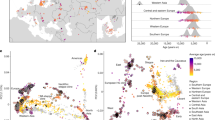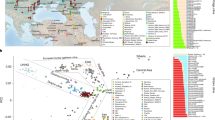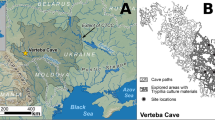Abstract
The North Pontic Region was the meeting point of the farmers of Old Europe and the foragers and pastoralists of the Eurasian steppe1,2, and the source of migrations deep into Europe3,4,5. Here we report genome-wide data from 81 prehistoric North Pontic individuals to understand the genetic makeup of its people. North Pontic foragers had ancestry from Balkan and Eastern hunter-gatherers6 as well as European farmers and, occasionally, Caucasus hunter-gatherers. During the Eneolithic period, a wave of migrants from the Caucasus–Lower Volga area7 bypassed local foragers to mix in equal parts with Trypillian farmers, forming the people of the Usatove culture around 4500 bce. A temporally overlapping wave of migrants from the Caucasus–Lower Volga blended with foragers instead of farmers to form Serednii Stih people7. The third wave was the Yamna—descendants of the Serednii Stih who formed by mixture around 4000 bce and expanded during the Early Bronze Age (3300 bce). The temporal gap between Serednii Stih and the Yamna is bridged by a genetically Yamna individual from Mykhailivka, Ukraine (3635–3383 bce), a site of archaeological continuity across the Eneolithic–Bronze Age transition and a likely epicentre of Yamna formation. Each of these three waves of migration propagated distinctive ancestries while also incorporating outsiders, a flexible strategy that may explain the success of the peoples of the North Pontic in spreading their genes and culture across Eurasia3,4,5,8,9,10.
This is a preview of subscription content, access via your institution
Access options
Access Nature and 54 other Nature Portfolio journals
Get Nature+, our best-value online-access subscription
27,99 € / 30 days
cancel any time
Subscribe to this journal
Receive 51 print issues and online access
199,00 € per year
only 3,90 € per issue
Buy this article
- Purchase on SpringerLink
- Instant access to full article PDF
Prices may be subject to local taxes which are calculated during checkout



Similar content being viewed by others
Data availability
Genotype data for individuals included in this study can be obtained from the Harvard Dataverse repository at https://doi.org/10.7910/DVN/CJTV3Q. The DNA sequences reported in this paper have been deposited in the European Nucleotide Archive under accession number PRJEB81468. Other newly reported data such as radiocarbon dates and archaeological context information are included in the manuscript and supplementary files.
References
Gimbutas, M. A. Three waves of the Kurgan people into Old Europe, 4500–2500 B.C. J. Indo-Eur. Stud. 18, 240–268 (1997).
Anthony, D. W. The Horse, the Wheel, and Language: How Bronze-Age Riders from the Eurasian Steppes Shaped the Modern World (Princeton Univ. Press, 2007).
Haak, W. et al. Massive migration from the steppe was a source for Indo-European languages in Europe. Nature 522, 207–211 (2015).
Allentoft, M. E. et al. Population genomics of Bronze Age Eurasia. Nature 522, 167–172 (2015).
Penske, S. et al. Early contact between late farming and pastoralist societies in southeastern Europe. Nature 620, 358–365 (2023).
Mathieson, I. et al. The genomic history of southeastern Europe. Nature 555, 197–203 (2018).
Lazaridis, I. et al. The genetic origin of the Indo-Europeans. Nature https://doi.org/10.1038/s41586-024-08531-5 (2024).
de Barros Damgaard, P. et al. The first horse herders and the impact of early Bronze Age steppe expansions into Asia. Science 360, eaar7711 (2018).
Narasimhan, V. M. et al. The formation of human populations in South and Central Asia. Science 365, eaat7487 (2019).
Lazaridis, I. et al. The genetic history of the Southern Arc: a bridge between West Asia and Europe. Science 377, eabm4247 (2022).
Kroonen, G., Jakob, A., Palmér, A. I., van Sluis, P. & Wigman, A. Indo-European cereal terminology suggests a Northwest Pontic homeland for the core Indo-European languages. PLoS ONE 17, e0275744 (2022).
Lipson, M. et al. Parallel palaeogenomic transects reveal complex genetic history of early European farmers. Nature 551, 368–372 (2017).
Nikitin, A. G., Videiko, M., Patterson, N., Renson, V. & Reich, D. Interactions between Trypillian farmers and North Pontic forager-pastoralists in Eneolithic central Ukraine. PLoS ONE 18, e0285449 (2023).
Burdo, N. B. Kul’turno-istoricheskiye kontakty ranne-tripol’skikh plemen. In Drevneyshiye Obshchnosti Zemledel’tsev i Skotovodov Severnogo Prichernomor’ya (ed. Yarovoy, E. V.) 49–51 (Nauchno-issledovatel’skaya laboratoriya «Arkheologiya» PGU im.T. G. Shevchenko, 2002).
Nikitin, A. G. et al. Mitochondrial DNA analysis of Eneolithic Trypillians from Ukraine reveals Neolithic farming genetic roots. PLoS ONE 12, e0172952 (2017).
Nikitin, A. G., Sokhatsky, M. P., Kovaliukh, M. M. & Videiko, M. Y. Comprehensive site chronology and ancient mitochondrial DNA analysis from Verteba Cave—a Trypillian Culture site of Eneolithic Ukraine. Interdiscip. Archaeol. 1, 9–18 (2010).
Gelabert, P. et al. Genomes from Verteba cave suggest diversity within the Trypillians in Ukraine. Sci Rep. 12, 7242 (2022).
Mattila, T. M. et al. Genetic continuity, isolation, and gene flow in Stone Age Central and Eastern Europe. Commun. Biol. 6, 793 (2023).
Kotova, N. S. Early Eneolithic in the Pontic Steppes (British Archaeological Reports, 2008).
Telegin, D. Ya. & Potekhina I. D. Neolithic Cemeteries and Populations in the Dnieper Basin (BAR International Series 383, 1987).
Telegin, D. Y. Keramika rannʹoho eneolitu typu Zasukha v lisostepovomu Livoberezhzhi Ukrayiny. Arkheolohiya 64, 73–84 (1988).
Nielsen, R. et al. Tracing the peopling of the world through genomics. Nature 541, 302–310 (2017).
Patterson, N., Price, A. L. & Reich, D. Population structure and eigenanalysis. PLoS Genet. https://doi.org/10.1371/journal.pgen.0020190 (2006).
Lazaridis, I. et al. Ancient DNA from Mesopotamia suggests distinct Pre-Pottery and Pottery Neolithic migrations into Anatolia. Science 377, 982–987 (2022).
South, A., Michael, S. & Massicotte, P. rnaturalearthdata: World vector map data from Natural Earth used in ‘rnaturalearth’. R package version 1.0.0.9000 https://github.com/ropensci/rnaturalearthdata, https://docs.ropensci.org/rnaturalearthdata/ (2024).
Ecsedy, I. The People of the Pit-Grave Kurgans in Eastern Hungary (Akadémiai Kiadó, 1979).
Govedarica, B. Zepterträger, Herrscher Der Steppen: Die Frühen Ockergräber Des Älteren Äneolithikums Im Karpatenbalkanischen Gebiet Und Im Steppenraum Südost-Und Osteuropas (Philipp von Zabern, 2004).
Posth, C. et al. Palaeogenomics of Upper Palaeolithic to Neolithic European hunter-gatherers. Nature 615, 117–126 (2023).
Haskevych, D. Late Mesolithic individuals of the Danube Iron Gates origin on the Dnipro River Rapids (Ukraine)? Archaeological and Bioarchaeological Records. Open Archaeol. 8, 1138–1169 (2022).
Mathieson, I. et al. Genome-wide patterns of selection in 230 ancient Eurasians. Nature 528, 499–503 (2015).
Skoglund, P. et al. Genomic diversity and admixture differs for Stone-Age Scandinavian foragers and farmers. Science 344, 747–750 (2014).
Malmström, H. et al. The genomic ancestry of the Scandinavian Battle Axe culture people and their relation to the broader Corded Ware horizon. Proc. R. Soc. B 286, 20191528 (2019).
Coutinho, A. et al. The Neolithic Pitted Ware culture foragers were culturally but not genetically influenced by the Battle Axe culture herders. Am. J. Phys. Anthropol. 172, 638–649 (2020).
Allentoft, M. E. et al. Population genomics of post-glacial western Eurasia. Nature 625, 301–311 (2024).
Rassamakin, Y. Y. Mohylʹnyky Ihrenʹ (Ohrinʹ) 8 ta Oleksandriya doby eneolitu: problemy datuvannya ta kulʹturnoyi prynalezhnosti. Arhelogia 4, 26–48 (2017).
Patterson, N. et al. Ancient admixture in human history. Genetics 192, 1065–1093 (2012).
Chintalapati, M., Patterson, N. & Moorjani, P. The spatiotemporal patterns of major human admixture events during the European Holocene. eLife 11, e77625 (2022).
Wang, C.-C. et al. Ancient human genome-wide data from a 3000-year interval in the Caucasus corresponds with eco-geographic regions. Nat. Commun. 10, 590 (2019).
Lazaridis, I. et al. Genetic origins of the Minoans and Mycenaeans. Nature 548, 214–218 (2017).
Skourtanioti, E. et al. Ancient DNA reveals admixture history and endogamy in the prehistoric Aegean. Nat. Ecol. Evol. 7, 290–303 (2023).
Clemente, F. et al. The genomic history of the Aegean palatial civilizations. Cell 184, 2565–2586.e21 (2021).
Korobkova, G. F. & Shaposhnikova, O. G. Poselenie Mikhailovka: Etalonnyj Pamyatnik Drevneyamnoj Kultury (Evropejskij Dom, 2005).
Kotova, N. S. Dereivskaya Kul’tura i Pamyatniki Nizhnemikhaylovskogo Tipa (Maidan: Kiev, Kharkov, 2013).
Rassamakin, Y. Y. in Late Prehistoric Exploitation of the Eurasian Steppe (eds Levine, M. et al.) 59–182 (McDonald Institute Monographs, 1999).
Nikitin, A. G. & Ivanova, S. in Steppe Transmissions (eds. Preda-Bălănică, B. & Ahola, M.) 9–27 (Archaeolingua, 2023); https://doi.org/10.33774/coe-2022-7m315.
Gimbutas, M. The Indo-Europeanization of Europe: the intrusion of steppe pastoralists from south Russia and the transformation of Old Europe. Word 44, 205–222 (1993).
Dabney, J. et al. Complete mitochondrial genome sequence of a Middle Pleistocene cave bear reconstructed from ultrashort DNA fragments. Proc. Natl Acad. Sci. USA 110, 15758–15763 (2013).
Korlević, P. et al. Reducing microbial and human contamination in DNA extractions from ancient bones and teeth. Biotechniques 59, 87–93 (2015).
Rohland, N., Harney, E., Mallick, S., Nordenfelt, S. & Reich, D. Partial uracil-DNA-glycosylase treatment for screening of ancient DNA. Philos. Trans. R. Soc. B 370, 20130624 (2014).
Rohland, N., Glocke, I., Aximu-Petri, A. & Meyer, M. Extraction of highly degraded DNA from ancient bones, teeth and sediments for high-throughput sequencing. Nat. Protoc. 13, 2447–2461 (2018).
Prendergast, M. E. et al. Ancient DNA reveals a multistep spread of the first herders into sub-Saharan Africa. Science 365, eaaw6275 (2019).
Gansauge, M.-T., Aximu-Petri, A., Nagel, S. & Meyer, M. Manual and automated preparation of single-stranded DNA libraries for the sequencing of DNA from ancient biological remains and other sources of highly degraded DNA. Nat. Protoc. 15, 2279–2300 (2020).
Fu, Q. et al. An early modern human from Romania with a recent Neanderthal ancestor. Nature 524, 216–219 (2015).
Behar, D. M. et al. A “Copernican” reassessment of the human mitochondrial DNA tree from its root. Am. J. Hum. Genet. 90, 675–684 (2012).
Li, H. & Durbin, R. Fast and accurate long-read alignment with Burrows–Wheeler transform. Bioinformatics 26, 589–595 (2010).
Fu, Q. et al. A revised timescale for human evolution based on ancient mitochondrial genomes. Curr. Biol. 23, 553–559 (2013).
Korneliussen, T. S., Albrechtsen, A. & Nielsen, R. ANGSD: analysis of next generation sequencing data. BMC Bioinformatics 15, 356 (2014).
Briggs, A. W. et al. Removal of deaminated cytosines and detection of in vivo methylation in ancient DNA. Nucleic Acids Res. 38, e87–e87 (2010).
Li, H. et al. The Sequence Alignment/Map format and SAMtools. Bioinformatics 25, 2078–2079 (2009).
Weissensteiner, H. et al. HaploGrep 2: mitochondrial haplogroup classification in the era of high-throughput sequencing. Nucleic Acids Res. 44, W58–W63 (2016).
Lazaridis, I. et al. Genomic insights into the origin of farming in the ancient Near East. Nature 536, 419–424 (2016).
Shinde, V. et al. An ancient Harappan genome lacks ancestry from Steppe pastoralists or Iranian farmers. Cell 179, 729–735.e10 (2019).
Harney, É. et al. Ancient DNA from Chalcolithic Israel reveals the role of population mixture in cultural transformation. Nat. Commun. 9, 3336 (2018).
Rivollat, M. et al. Ancient genome-wide DNA from France highlights the complexity of interactions between Mesolithic hunter-gatherers and Neolithic farmers. Sci. Adv. 6, eaaz5344 (2020).
Reich, D. et al. Reconstructing Native American population history. Nature 488, 370–374 (2012).
Skoglund, P. et al. Reconstructing prehistoric African population structure. Cell 171, 59–71.e21 (2017).
Wang, K. et al. Ancient genomes reveal complex patterns of population movement, interaction, and replacement in sub-Saharan Africa. Sci. Adv. 6, eaaz0183 (2020).
Lipson, M. et al. Ancient DNA and deep population structure in sub-Saharan African foragers. Nature 603, 290–296 (2022).
Fu, Q. et al. The genetic history of Ice Age Europe. Nature 534, 200–205 (2016).
Jones, E. R. et al. Upper Palaeolithic genomes reveal deep roots of modern Eurasians. Nat. Commun. 6, 8912 (2015).
Alexander, D. H., Novembre, J. & Lange, K. Fast model-based estimation of ancestry in unrelated individuals. Genome Res 19, 1655–1664 (2009).
Fenner, J. N. Cross-cultural estimation of the human generation interval for use in genetics-based population divergence studies. Am. J. Phys. Anthropol. 128, 415–423 (2005).
Acknowledgements
The authors thank D. Anthony for a critical review of a manuscript draft; N. Burdo, E. Kaiser, Y. Rassamakin and S. Razumov for stimulating discussions; S. Agulnikov, J. Burger, T. Demchenko, V. Haheu, V. Sinica, M. Sokhatsky and E. Yarovoy for sharing samples; I. Olalde for bioinformatic support; and R. Bernardos, N. Broomandkhoshbacht, N. Adamski, M. Ferry, I. Greenslade, Z. Zhang, K. Stewardson and A. Locher for technical support. We acknowledge the Institute of Archaeology at the National Academy of Sciences of Ukraine in Kyiv, and the National History Museum of Moldova in Chișinău, as the leading institutions dedicated to preserving prehistoric cultural heritage in the two countries from which most of the newly reported samples in this study come. We acknowledge the contribution of Ukrainian archaeologists Mykola Makarenko (1877–1938) and Dmytro Telegin (1919–2011) as leaders of the excavations that produced many of the samples featured in this report and for providing the theoretical groundwork that inspired many of the hypotheses tested here. The research was supported by GVSU Faculty Development and Student Research funds to A.G.N. and S.S. We acknowledge support from the National Science Foundation (grants BCS-0922374 and BCS-2208558 supporting V.R.); the National Institutes of Health (HG012287); the John Templeton Foundation (grant 61220); from Jean-Francois Clin; from the Allen Discovery Center, a Paul G. Allen Frontiers Group advised programme of the Paul G. Allen Family Foundation (D.R.); and from the Howard Hughes Medical Institute (D.R.). The author-accepted version of this article, that is, the version not reflecting proofreading and editing and formatting changes following the article’s acceptance, is subject to the Howard Hughes Medical Institute (HHMI) Open Access to Publications policy, as HHMI lab heads have previously granted a nonexclusive CC BY 4.0 license to the public and a sublicensable license to HHMI in their research articles. Pursuant to those licences, the author-accepted manuscript can be made freely available under a CC BY 4.0 license immediately upon publication.
Author information
Authors and Affiliations
Contributions
A.G.N., I.L., S.I., V.D., M.L. I.P. and D.R. conceived the study. A.G.N., I.L., N.P. and D.R. supervised data analysis. A.G.N., S.S., V.R. and D.R. secured funding for the study. A.G.N., S.I., M.V., V.D., N.K., M.L., I.P., M.K.-N., S.L., S.M., H.S., G.S. and T.T. provided samples for the study. I.L., N.P. and D.R. supervised or performed statistical analyses. A.G.N., V.R., S.S., K.C., E.C., E.H., L.I., A.M.L., M. Michel, M. Mah, A.M., J.O., L.Q., J.N.W., F.Z., S. Mallick and N.R. performed laboratory and bioinformatic analyses. A.G.N. and A.K. curated the samples. N.P., M.L., N.K., S.M., S.L., H.S., S.S., P.W. and D.R. critically reviewed and edited manuscript files. A.G.N. and I.L. wrote the manuscript with input from all co-authors.
Corresponding authors
Ethics declarations
Competing interests
The authors declare no competing interests.
Peer review
Peer review information
Nature thanks Kristian Kristiansen and the other, anonymous, reviewer(s) for their contribution to the peer review of this work. Peer review reports are available.
Additional information
Publisher’s note Springer Nature remains neutral with regard to jurisdictional claims in published maps and institutional affiliations.
Extended data figures and tables
Extended Data Fig. 1 Admixture proportions of 4-source model with Trypillians as the 4th source.
Plotted populations fit the model (p > 0.05) and we only show populations where the RMSE of standard errors (S.E.) is less than 10% of the point estimate (shown above each bar). For full list of tested populations and alternative choices of modelling, see Supplementary Information Section 2, Appendix I. Sample sizes are in Online Table 4 of ref. 7.
Extended Data Fig. 2 Admixture proportions of 4-source model with Steppe Maykop as the 4th source.
Plotted populations fit the model (p > 0.05) and we only show populations where the RMSE of standard errors (S.E.) is less than 10% of the point estimate (shown above each bar). For full list of tested populations including sample sizes and alternative choices of modelling, see Supplementary Information Section 2, Appendix II. Sample sizes are in Online Table 4 of ref. 7.
Supplementary information
Supplementary Information
Supplementary Information sections 1–4, including Supplementary Figures and Tables – see Contents for details.
Supplementary Tables
Supplementary Tables 1–5
Rights and permissions
Springer Nature or its licensor (e.g. a society or other partner) holds exclusive rights to this article under a publishing agreement with the author(s) or other rightsholder(s); author self-archiving of the accepted manuscript version of this article is solely governed by the terms of such publishing agreement and applicable law.
About this article
Cite this article
Nikitin, A.G., Lazaridis, I., Patterson, N. et al. A genomic history of the North Pontic Region from the Neolithic to the Bronze Age. Nature 639, 124–131 (2025). https://doi.org/10.1038/s41586-024-08372-2
Received:
Accepted:
Published:
Issue Date:
DOI: https://doi.org/10.1038/s41586-024-08372-2



